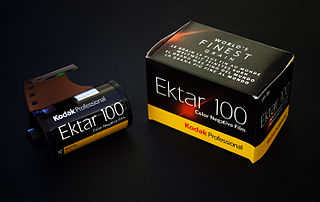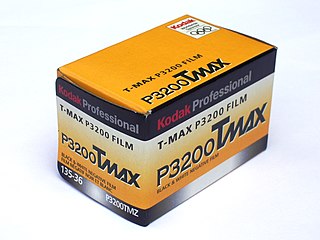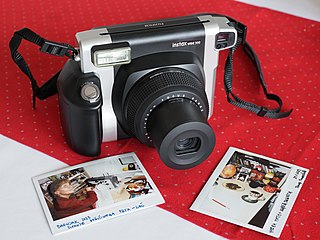
Fujifilm Holdings Corporation, trading as Fujifilm, or simply Fuji, is a Japanese multinational conglomerate headquartered in Tokyo, Japan, operating in the realms of photography, optics, office and medical electronics, biotechnology, and chemicals.

Velvia is a brand of daylight-balanced color reversal film produced by the Japanese company Fujifilm. The name is a portmanteau of "Velvet Media", a reference to its smooth image structure. The original incarnation of the film was called "Velvia for Professionals", known as RVP, a classification code meaning "Reversal/Velvia/Professional series". It is known for its extremely high level of color saturation and image quality.

Instant film is a type of photographic film that was introduced by Polaroid Corporation to produce a visible image within minutes or seconds of the photograph's exposure. The film contains the chemicals needed for developing and fixing the photograph, and the camera exposes and initiates the developing process after a photo has been taken.

Technical Pan is an almost panchromatic black-and-white film that was produced by Kodak. While it can reproduce the visible light spectrum, it leans to the red, and so unfiltered outdoor shots render blues, most notably the sky, with additional darkening and reds with some lightening. It was generally used as a very slow film, rated at EI 25 or even 16, although it could be rated at up to EI 320 with a distinct loss of tonal range and a bunching of shadow and highlight detail. This film has unmatched fine grain, especially when rated at a low speed, and makes excellent enlargements while preserving fine details. Kodak stopped selling it in 2004. It has not been replaced by a film with its characteristics. Although some of its particularities were unique and no emulsion in actual production could replace it, its resolution capabilities were surpassed by another film by ADOX, CMS 20 II.

Ektachrome is a brand name owned by Kodak for a range of transparency, still and motion picture films previously available in many formats, including 35 mm and sheet sizes to 11 × 14 inch size. Ektachrome has a distinctive look that became familiar to many readers of National Geographic, which used it extensively for color photographs for decades in settings where Kodachrome was too slow. In terms of reciprocity characteristics, Ektachrome is stable at shutter speeds between ten seconds and 1/10,000 of a second.

Kodak Ektar is a professional color negative film introduced in 2008, designed for nature, outdoors, fashion, and product photography. The film offers ultra-fine grains, ultra-vivid colors, and high saturation, and is available in ISO 100 only.

The ADOX brand for photographic purposes has been used by three different companies since its original conception over one hundred fifty years ago. ADOX was originally a brand name used by the German company, Fotowerke Dr. C. Schleussner GmbH of Frankfurt am Main, the world's first photographic materials manufacturer. In 1962 the Schleussner family sold its photographic holdings to DuPont, an American company. DuPont used the brand for its subsidiary, Sterling Diagnostic Imaging for X-ray films. In 1999, Sterling was bought by the German company Agfa. Agfa did not use the brand and allowed its registration to lapse in 2003. Fotoimpex of Berlin, Germany, a company founded in 1992 to import photographic films and papers from former eastern Europe immediately registered the brand and today ADOX is a brand of black and white films, photographic papers and photochemistry produced by ADOX Fotowerke GmbH based in Bad Saarow near Berlin.

Provia is a brandname for a pair of daylight-balanced color reversal films produced by the Japanese film company Fujifilm. It is currently available in one speed, 100/21°, marketed as Fujichrome Provia 100F Professional [RDP III],. An additional speed of 400/27°, marketed as Fujichrome Provia 400X Professional [RXP], was previously available.

Analog photography, also known as film photography, is a term usually applied to photography that uses chemical processes to capture an image, typically on paper, film or a hard plate. These processes were the only methods available to photographers for more than a century prior to the invention of digital photography, which uses electronic sensors to record images to digital media. Analog electronic photography was sometimes used in the late 20th century but soon died out.

Fujicolor Superia is a Fujifilm brand of daylight balanced colour negative film introduced ca.1998 primarily aimed at the consumer market, but was also sold in a professional 'press' variant. A key feature at launch was the '4th' cyan colour layer designed to provide improved colour reproduction under fluorescent lighting. Its Kodak equivalent is the Kodacolor Gold/Ultramax line.

Tri-X is a black and white photographic film produced by the Eastman Kodak Company. Since 2013 it is distributed by Kodak Alaris which controls the Kodak Professional product line under which it is grouped. The combination of hand-held cameras and high-speed Tri-X film was transformative for photojournalism and for cinema.

Kodak Professional T-MAX Film is a continuous tone, panchromatic, tabular-grain black and white negative film originally developed and manufactured by Eastman Kodak since 1986. It is still manufactured by Eastman Kodak but distributed and marketed by Kodak Alaris, as with other products under Kodak Professional banner.

Instax is a brand of instant still cameras and instant films marketed by Fujifilm.
Fujicolor Pro was a line of professional color negative films from Japanese company Fujifilm introduced in 2004 for weddings, portraits, fashion and commercial photography. It originally comprised four emulsions: Pro 160S, Pro 160C, Pro 400H and Pro 800Z. Its main competitor was Kodak Portra.

Kodak Portra is a family of daylight-balanced professional color negative films originally introduced in 1998 made mainly for portrait and wedding applications. They are successors of the professional Vericolor films, which succeeded Ektacolor films earlier. The films are available in three speeds — 160, 400, and 800 ISO — with the 160 and 400 speed formerly available as "natural color" (NC) and "vivid color" (VC) varieties before the 2011 update.

Photographic film is a strip or sheet of transparent film base coated on one side with a gelatin emulsion containing microscopically small light-sensitive silver halide crystals. The sizes and other characteristics of the crystals determine the sensitivity, contrast, and resolution of the film. Film is typically segmented in frames, that give rise to separate photographs.

Foma Bohemia spol. s.r.o is a photographic company based in Hradec Králové, Czech Republic established in 1921, originally as Fotochema, being renamed in 1995 on privatisation. They are mostly known for their line of black and white films and papers but also produce movie film, X-ray films for medicine and industry and personal dosimetry film along with processing chemicals. They formerly produced aerial and surveillance films.



















